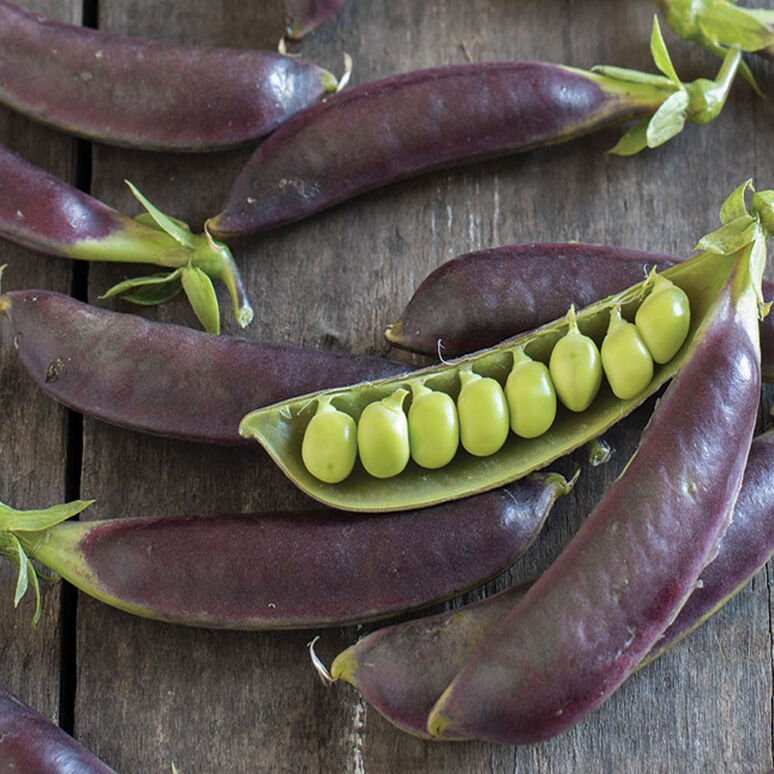Royal Snap II Pea
Pisum sativum • Hybrid
Old-fashioned stumpy carrot that blasts through clay soils
A dazzling deep, purple snap pea that is firm and crisp with a satisfying snap.
JOY MAX SCALE ✦✦✦✦✧
✦ Hybrid developed by the breeder of Sugar Snap, Dr. Calvin Lamborn, the father of the snap pea and breeder of the classic Sugar Snap.
✦ They are entirely edible, no shelling needed. Just pull the string off the back.
✦ The peas grow from beautiful violet and dark-purple bi-coloured flowers. The maroon pods with contrasting bright green interiors turn vibrant purple at the point of maximum maturity.
✦ They are most colourful & tasty when served raw or prepared with a light blanching or quick sauté.
✦ These are a shorter pea and don’t require trellising but it is very helpful to use sticks you find in the yard as supports as they grow.
✧ Peas are prone to powdery mildew and fusarium wilt. To help them flourish, avoid getting water on the leaves.
Peas are nitrogen-fixing plants: They take nitrogen from the air and change it into a form that they can use for food, improving the soil around them.
Basic Growing Information
Seeds germinate well in cold, but well-drained soil. Sow 1/2-1” deep, 1-2” apart in a 3” band (25 seeds/ft.) Do not thin. Use branched sticks you find in the yard and stick them in the middle of the band of peas as they grow. This variety is short and doesn’t require trellising but the short branches will give them a little extra support and make them easier to harvest.
Using soil inoculate will help them form nitrogen-producing nodules on the roots.
Pisum sativum HARDINESS ZONE: Annual 3-10 PLANT HEIGHT: 24-36” PLANT WIDTH: 5” SEED SPACING: 1/2-1” SEED DEPTH: 1/2-1" Do not thin. IDEAL TEMP: 55-70°F GERMINATION: 6-10 days DAYS TO MATURITY: 58 SOIL: Loose, loamy, well-drained, not too much nitrogen LIGHT: Full Sun
Tips for Growing Peas
Peas are a cool-weather crop. Midsummer pickings are not as prolific as earlier harvests. Plant the first sowing in early spring as soon as the soil can be worked.
Inoculate peas to encourage formation of nitrogen-producing nodules on the plant roots. This enriches the soil, results in larger plants, and increases yield. Pea inoculate can be purchased at garden stores or online.
Fusarium wilt is the most common disease of sugar snap peas. Infected plants have yellow, wilting leaves, particularly the lower leaves. To keep it from happening, make sure soil drains well and keep water off the plants when watering.
Use scissors to harvest or hold vine with one hand and pick the pods with the other; vines are fragile.
Pay attention to peas, if they overmature and remain unpicked, it reduces the yield.
After picking, you can store it in the fridge. It will remain suitable to eat for the next five to seven days. For saving it more extended period, you can freeze it after washing and cleaning it properly.
You can also dry the peas and store it in a sealed container to use it in soups. It won’t taste as good as a fresh pea, but you will be able to enjoy it long after harvesting. At the end of the season, don’t pull vines. Snip at soil level to keep the nitrogen the peas fixed in the soil. The vines make great green mulch.
Companion Planting
Alyssum, beans, carrots, lettuce, celery, corn, melons, cucumbers, eggplant, peppers, radishes, spinach, and turnips. Avoid alliums: onions and garlic.




